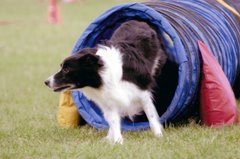Ingestion of the larvae results in one of two scenarios. In the simple version the larvae continue to the intestinal tract and remain there where they mature and reproduce, perpetuating the life cycle. Sometimes though the ingested larvae are more adventurous and migrate to the respiratory tract where they are coughed up and swallowed just as in the roundworm life cycle. Once back in the intestines, they mature and continue like normal. In the ingestion of the secondary host the encysted larvae are released into the intestines of the dog where they also mature.
 |
| Hookworms in the intestine |
When the adventurous larvae mentioned above travel to the respiratory tract they don't all make it, and end up encysted in various tissues in the body. These encysted larvae account for the last scenario. Pregnancy, for some reason, causes the larvae to come out of the cyst and travel to the mammary gland and the puppies are affected through nursing.
Mature hookworms attach to the intestinal wall and feed off the hosts blood. This can cause a severe anemia (low red blood cell count) in puppies. Severely infections can require intensive care, blood transfusions and may even result in death. Fortunately hookworms are susceptible to most common dewormers. Deworming puppies every 2 weeks for several weeks will usually clear the infection. Most heartworm preventatives also deworm for hookworms monthly.
 |
| Hookworm teeth |
Hookworms are small (about 1/2-3/4 inches long) and are rarely seen in stool. This is due not only to their small size but also because they attach so firmly to the intestines that live worms do not often pass in the stool. Diagnosis is usually made by seeing the eggs on a fecal flotation. Hookworm eggs can only survive a few months in the environment and are killed by freezing.
 |
| Hookworm egg |
Zoonotic potential
Hookworms can also affect humans. Most common cause is by penetration of the skin-especially from walking barefoot through contaminated soil or sand. This causes a very itchy, but typically treatable, skin lesion. Common sense and good hygiene will help prevent this.


.jpg)
.jpg)



.jpg)



2 comments:
I know that we should leave comments so that you know we are reading these posts... but the only thing I can come up with is... ewwwwww
Glad I had finished my lunch before I read this.
I think my mom felt the same way-but thanks for reading!
Post a Comment